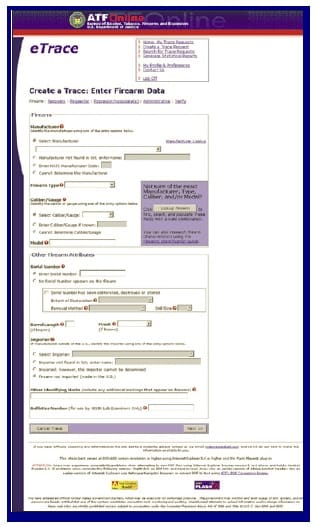TTAG’s ATF Deep Throat writes . . . “You may find this quote from an ATF (Bureau of Alcohol, Tobacco, Firearms and Explosives) newsletter of interest: ‘ATF traces firearms for more than 50 foreign countries each year, either through eTrace or via request by Interpol. ATF has no record of an American being at risk in a foreign country as a result of innocent involvement in the history of a firearm subsequently recovered and traced by a law enforcement agency.’ Exactly how would ATF be notified of “an American being at risk”? Will the poor American schmuck phone ATF from their cell in Mexico to tell them, “I’m at risk!”? Or will the corrupt Mexican police send an email to ATF? Or maybe the Colombians will send a letter to ATF . . .
“The identity of the firearms purchaser provided to a foreign law enforcement agency is of particular concern to people, because the purchaser is not necessarily involved in any crime. FFL and retail purchasers of firearms recovered in crimes by law enforcement may not have committed any crime”
True! So why are our names and addresses of American firearms purchasers turned over to foreign cops?
I’m sure ATF patiently explains to all the foreign, eTrace-trained (your tax money hard at work) law enforcement agents that the American firearms purchasers flagged by eTrace are probably innocent. Until proven guilty. In an American court.
And I’m sure that Americans who happen to live, work or visit these countries would not be on a list that could potentially subject to surveillance, detention, interrogation, incarceration (with all that term implies), arrest or imprisonment. Because all of the dozens of countries wired into the eTrace system are corruption-free and respect Americans’ constitutional rights.
It’s entirely possible that a gun that was stolen from you, or lost, or incorrectly entered into a database, could create a series of events that will land you and/or your family in a foreign prison. Have you seen the TV series Locked Up Abroad? Not pretty. And even here, in the good old USA, eTrace may be working against your best interests.
Here’s some choice eTrace quotes from a Police Chief Magazine’s Officer Safety: The Threat of the Armed Gunman: Using Firearms Tracing to Reduce Armed Violence by Special Agent Benjamin R. Hayes, Chief, Law Enforcement Support Branch, National Firearms Tracing Center, Bureau of Alcohol, Tobacco, Firearms, and Explosives, Martinsburg, West Virginia:
An individual trace also often identifies a straw purchaser—an individual who claims that the firearm will be for his or her own use, but is actually purchasing it for someone else. That someone else is generally prohibited by law from purchasing or possessing a firearm, or seeks to hide the firearm acquisition. Hidden purchasers include felons, active criminals, and persons with clear criminal intent.
The straw purchaser becomes party to the crime by placing a lethal weapon in a criminal’s hands. Straw purchasing is never an isolated criminal act: it is a conspiracy that frequently reveals active criminal associations and enterprises, including gang and narcotics activity.
An individual firearms trace can be used to prove a lie and identify witnesses, suspects, and previously unidentified coconspirators. Single firearms traces have proven to be key to solving violent crimes such as homicide and rape.”
This is exactly the kind of obfuscation that allow “may issue” states to claim they’re respecting Americans’ Second Amendment right to keep and bear arms. Or, as RF likes to call it, the “If One Child is Saved” argument.
Nowhere in this FAQ-fest does Officer Hayes give readers hard statistical data proving that eTrace is any more effective for crime fighting than any other investigative technique. “Often identifies.” “Frequently reveals.” “Have proven to be key.” Etc.
In fact, it’s extremely difficult to prove a straw purchase in court—despite the enormous amount of time, effort and tax money required to maintain eTrace. And as I said, the database is hardly reliable. An innocent gun owner could be caught-up in an investigation that will ruin their lives.
eTrace’s referral list identifies other departments and agencies with information in common and provides the contact information for their linked traces. A referral list is included in every trace result. Specifically, if a department’s firearms trace has a purchaser and/or possessor who match by date of birth and name, or a firearms licensee, and/or a recovery location in common, this list will display the name and contact information for the other department or agency. This remarkable resource can make departments with common points able to work together if warranted.
Take a second to contemplate the full glory of that last sentence, suffused with bureaucratic doublespeak and CYA logic as it is. Then consider the fact that the ATF is encouraging law enforcement agencies around the United States—and the world—to share eTrace data with each other.
“If warranted.” Do we really want to trust every cop in creation to decide if firearms purchase information should be disseminated to all and sundry without probable cause that a crime has been committed, as proven in advance to a judge? Does the fact that only “crime guns” are traced reassure you that the system is good for society in general and you, a gun owner, in specific?
Maybe that’s why the federal government is legally prohibited from maintaining a national firearms registry. A fact that the ATF seems to have forgotten.”





Stop picking on the BATFE. They're just following orders. Yes, like that bunch in Germany.
Comments are closed.